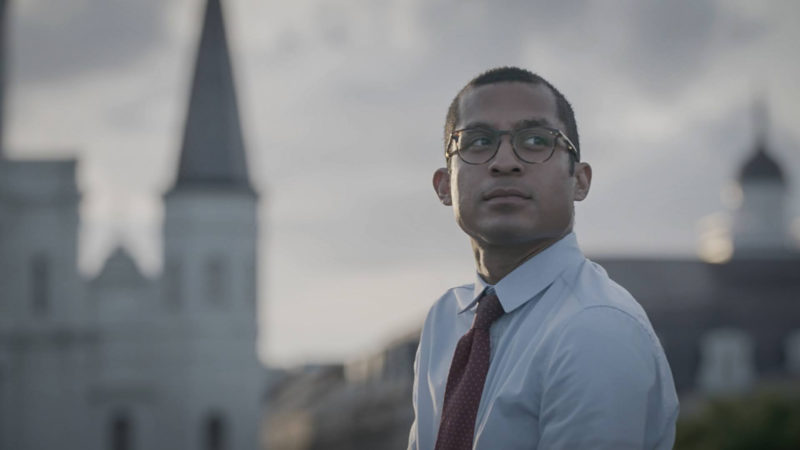‘Waking up to racism’: New documentary tells truth about Confederacy, tracks root of ‘Lost Cause’ myth
Share
Explore Our Galleries
Breaking News!
Today's news and culture by Black and other reporters in the Black and mainstream media.
Ways to Support ABHM?
By Liz Vinson, SPLC
Living in New Orleans in 2015, CJ Hunt was frustrated that Confederate symbols still occupied the city’s common spaces – or “neutral grounds” – intended for all citizens, which he called “absurd.” At the time, the nation was reeling from the deadly attack at the historic Emanuel AME Church in Charleston, South Carolina, where nine Black people were killed by a young white supremacist who had posted a picture of himself with a Confederate flag.
But when the state of South Carolina removed the Confederate flag from its capitol, Hunt could tell a powerful movement was brewing to remove Confederate symbols nationwide. In New Orleans, the organizers of Take ‘Em Down NOLA, a grassroots organization that has fought for the removal of Confederate monuments, were already marching in the streets, and the mayor took the calls to remove those statues seriously when he demanded the removal of four monuments. The backlash, Hunt said, was intense.

That same year, Hunt – a biracial comedian who now works as a field producer for The Daily Show – decided to capture why many of his white Southern neighbors become angry and even violent when Confederate monuments are taken down.
His debut feature documentary, The Neutral Ground, not only exposes why Southerners cling to Confederate iconography but also challenges the “Lost Cause” mythology – a romanticized, and false, version of Southern history in which the Confederacy and its leaders were fighting for “states’ rights” and defending their region against Northern aggression.
“While the Confederacy was not successful at winning wars, it was incredibly successful when it came to creating a myth,” Hunt, 36, told the Southern Poverty Law Center. “When people want to say the Confederacy was not about slavery, those claims are not grounded in facts or supported by the Confederacy’s own founding documents.”

For the documentary, which won a Special Jury Mention at the 2021 Tribeca Film Festival, Hunt and his producing partner Darcy McKinnon teamed up with Courtney Staton, a Black organizer and filmmaker who co-organized the removal of the University of North Carolina at Chapel Hill’s Confederate monument, Silent Sam. As the film’s impact producer, Staton worked to ensure the film could be a springboard to transform the way people think about the “Lost Cause.”
“I wanted to find a way where we can end this conversation about white violence misinformation and talk about Black history and resistance,” Staton said. “Impact producing takes the documentary one step farther and asks how a film can change power on the ground – in this case, piercing the pernicious myth of the Lost Cause.”
Producing the film led Hunt to a better comprehension of the white resentment and vitriol plaguing the country and how white supremacy comes at the expense of his Blackness – and that of others.
“The journey of looking at the Confederacy absolutely helped me understand my Blackness in a different way,” he said. “The journey of the film is the journey of me learning that my own Blackness must be grounded in something more than a confrontation with white supremacy, whether you’re chasing whiteness to possess it or expose it. I hope the film gives to all people of color the chance to ask, ‘What does it look like to give up the chase?’”…
Hunt hopes the documentary will help defend teachers against laws that make telling the full story illegal.
“Lawmakers are making it harder to teach the truth about history,” Hunt said. “Teachers are on the offense, and our defensive strategy is to push back against these lawmakers who are doing what the Lost Cause has always done.”…
Hunt and Staton’s approach is to develop materials educators can use right away, without limitations, and work with teachers who are already teaching about slavery and the Civil War.
“What I really love about The Neutral Ground is its emphasis on the truth,” said Jalaya Liles Dunn, director of the SPLC’s Learning for Justice (LFJ) program. “It corrects so many of the lies we’ve been told and taught about our history by lifting up the facts and the primary documents that support them. In fact, it aligns nicely with the key concepts of LFJ’s Teaching Hard History framework. For educators, we’ve already created resources to help them do this history justice in the classroom, and this film could be used in whole as more professional learning on the subject or in part as a classroom resource.”…
*The Neutral Ground is currently airing on the Public Broadcasting Service. Watch here.
Read the full article here.
More Breaking News here.









Comments Are Welcome
Note: We moderate submissions in order to create a space for meaningful dialogue, a space where museum visitors – adults and youth –– can exchange informed, thoughtful, and relevant comments that add value to our exhibits.
Racial slurs, personal attacks, obscenity, profanity, and SHOUTING do not meet the above standard. Such comments are posted in the exhibit Hateful Speech. Commercial promotions, impersonations, and incoherent comments likewise fail to meet our goals, so will not be posted. Submissions longer than 120 words will be shortened.
See our full Comments Policy here.